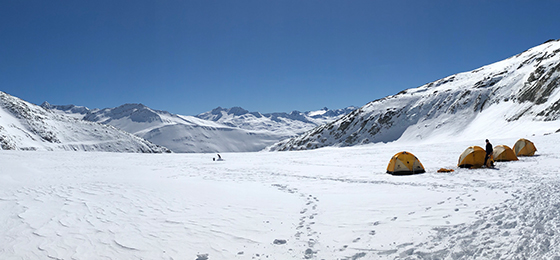May 18 2020
Seismic tracking of glaciers is crucial to gain improved insights into their development and to forecast risks. Professor Fabian Walter from the Swiss National Science Foundation has developed a new monitoring tool using optical fibers. The fibers can monitor the glaciers as a whole.
 Image Credit: Swiss National Science Foundation.
Image Credit: Swiss National Science Foundation.
Glaciers tend to move continuously and require tracking. Satellite images offer hints regarding their development. Seismology involves listening to glaciers from within them, thus allowing researchers to gain insights into how they moves, with higher precision.
But seismometers are challenging to install in glacial regions. Therefore, seismic tracking coverage of glaciers is irregular. In the latest research, Fabian Walter, an SNSF Professor at ETH Zurich, illustrated that it is also feasible to track glaciers through optical fibers.
The fibers are not only simple to install compared to seismometers but they also provide more measuring points. Therefore, the fibers represent a method of expanding seismic tracking coverage in regions that are hard to access.
One Measuring Point Every Two Meters
The outcomes of the study were recently reported in the Nature Communications journal, and the study was performed at an altitude of 2,500 m on the Rhone Glacier in the extreme north-east of the canton of Valais.
In March 2019, two groups under Fabian Walter and Andreas Fichtner, an expert in seismology and wave physics at ETH Zurich, recorded micro-earthquakes for five days with the help of a 1 km fiber optic cable that was set up a few centimeters inside the snow cover on the surface of the glacier.
Distributed acoustic sensing was the technique employed to record disturbances in the optical signal—caused by seismic events inside the glacier—at uniform intervals of multiple meters along the cable. The recordings were transformed into seismograms.
Fabian Walter describes that installing a considerably larger number of sensors throughout the same monitoring area—500 measuring points served as sensors along the 1-km cable—enabled the collected data to have more information compared to those from seismometers, specifically with regards to localization of icequakes and rockfalls.
Furthermore, the cable provided improved insight into the uneven, unclear movements by which the glacier shifts. New kinds of seismic waves were discovered, and this had not been feasible earlier using seismometers.
In the ice sheets of the Antarctic and Greenland, irregular movements of this kind were previously known to take place, but this was the first time their presence was accurately confirmed in the Alps.
What is Happening Inside the Ice?
Although optical fibers were utilized to track earthquakes under certain conditions even earlier, icequake expert Fabian Walter is one of the first researchers to use this technology for glaciers.
There are other teams already working on the subject–in Alaska, for example–because fiber optic technology offers benefits in this type of challenging environment. Whereas it often takes several hours to install a seismological station capable of covering only a tiny part of a glacier, all we have to do now is lay out the cable and we have hundreds of sensors. In theory, the technology enables us to cover and monitor entire glaciers.
Fabian Walter, Professor and Icequake Specialist, Swiss National Science Foundation
Walter performed this research in collaboration with the Swiss Seismological Service at ETH Zurich.
The fiber optic cable also quantifies seismic velocities, thereby offering more information, like details of the ice composition. It also allows researchers to quantify the rates of ice deformation and know the process through which crevasses develop.
Apart from the glacier regions, other applications for this technology are yet to be tested. Already, optical fibers have been installed alongside railways and roads, as well as near a few infrastructure installations. Dark fiber—namely, optical fibers that have been installed but are not functioning—could be employed to track seismic events and avoid harm.
Journal Reference:
Walter, F., et al. (2020) Distributed acoustic sensing of microseismic sources and wave propagation in glaciated terrain. Nature Communications. doi.org/10.1038/s41467-020-15824-6.